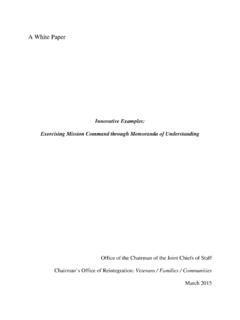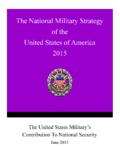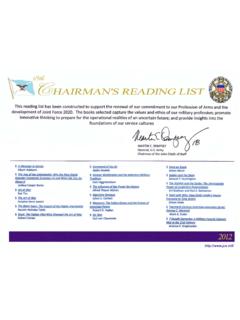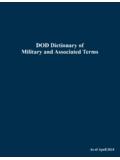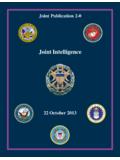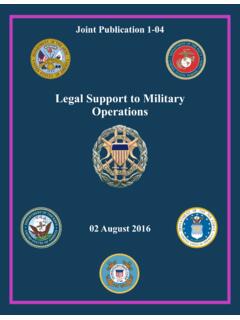Transcription of Commander’s Handbook for Assessment Planning and …
1 Commander s HandbookforAssessment Planning and ExecutionVersion Staff, J-7 Joint and Coalition WarfightingSuffolk, Virginia9 September 2011 DEPUTY DIRECTOR, J-7 JOINT STAFF JOINT AND COALITION WARFIGHTING 116 LAKE VIEW PARKWAY SUFFOLK, VA 23435-2697 MESSAGE TO JOINT WARFIGHTERS As the Joint Staff J-7 continues to interact with the combatant commands and Services, we recognize that there is very little how to doctrinal guidance on Planning and executing assessments. Consequently, we have developed this pre-doctrinal Handbook to help joint force commanders and their staffs understand the scope and importance of Assessment and provide information and guidance on its process; best practices; Planning , and execution.
2 This Handbook was written to provide needed detail to military planners and is based on extensive lessons learned and best practices gained throughout the joint environment. Assessment is a key component of joint operation Planning as described in keystone documents in the joint publication series, and outlines the basic process for conducting Assessment . However, these joint publications contain considerable top-level discussion of Assessment and lack the level of detail needed by staffs tasked to conduct Assessment . This Handbook describes detailed procedures that can be used to measure progress in achieving desired results.
3 This Handbook is descriptive, not prescriptive. It is offered as a practical method for assessing the Planning and execution of joint operations. Joint force commander s around the world routinely conduct Assessment as a part of their day-to-day battle rhythms, and numerous headquarters have used the procedures described in this Handbook during exercises and operations. We hope this Handbook stimulates the joint community s thinking about how to address assessments. We encourage you to use the information in this Handbook and provide feedback to help us capture value-added ideas for incorporation in emerging joint doctrine, training, and professional military education.
4 FREDERICK S. RUDESHEIM Major General, Army Deputy Director, J-7, Joint Staff, Joint and Coalition Warfighting i PREFACE 1. Scope This Handbook provides an understanding of the processes and procedures being employed by joint force commanders and their staffs to plan and execute Assessment activities. It provides fundamental principles, techniques, and considerations related to Assessment that are being employed in the field and are evolving toward incorporation in joint doctrine. Furthermore, this Handbook supplements doctrinal publications by providing detailed guidance to conduct effects Assessment , task Assessment , and deficiency analysis.
5 2. Purpose This Handbook provides users with a pre-doctrinal reference describing how to conduct Assessment execution and Planning . Its primary purpose is to improve the US military s Assessment process through educating the user on basics, best practices, and processes. 3. Content This Handbook complements and expands upon the overarching concepts and principles that have been incorporated into keystone joint doctrinal publications, to include joint publications 3-0, Joint Operations; 5-0, Joint Operation Planning ; and 2-0, Joint Intelligence. It supports requirements of joint operation Planning and offers techniques and procedures currently used in the field.
6 It is intended as a reference for joint forces conducting Assessment as an element of a joint operation. 4. Development This Handbook was developed based on observations at combatant commands as well as joint task force staffs. It was developed in close coordination with, and used significant input from, both civilian and military subject matter experts. Assessment is a collaborative effort between the joint force, interagency and multinational partners, and other stakeholders. As such, this Handbook addresses the necessity for an inclusive Assessment process and effort at every level. It also presents some Assessment resources developed by other stakeholders and currently in use throughout the world.
7 5. Application This Handbook is not approved joint doctrine, but is a non-authoritative supplement to current extremely limited, documentation on the Assessment process. This publication is primarily intended for use by combatant command or joint force headquarters personnel responsible for Assessment at the strategic theater, and/or operational level. Preface ii Commander s Handbook for Assessment Planning and Execution 6. Contact Information Comments and suggestions on this important topic are welcomed. Points of contact regarding this Handbook are Mr. Michael McGonagle, 757-836-9883 DSN 668-9883, Mr. Marc Halyard, 757-203-5508, DSN 668-5508, and Mr.
8 Walter Ledford, 757-203-6155, DSN 668-6155, iii TABLE OF CONTENTS PAGE EXECUTIVE SUMMARY .. vii CHAPTER I Assessment OVERVIEW General .. I-1 The Purpose of Assessment in Joint Operations .. I-2 Understanding Assessment Terminology .. I-6 Assessment Levels .. I-7 Use of Effects .. I-8 Organization .. I-9 Intelligence Support to Assessment .. I-9 Assessment Relationships Across Multiple Levels .. I-10 CHAPTER II Assessment PROCESS General .. II-1 The Assessment Process .. II-2 Combine Quantitative and Qualitative Indicators .. II-7 Incorporate Formal and Informal Methods .. II-9 Use Caution When Establishing Cause and Effect.
9 II-10 Consider Operations Research/Systems Analysis Support .. II-11 Other Assessment Frameworks .. II-12 CHAPTER III Assessment COMPONENTS General .. III-1 Objectives and Effects .. III-2 Measures and Indicators .. III-4 Developing Measures of Performance .. III-7 Developing Measures of Effectiveness and Indicators .. III-9 Develop Indicator Threshold Criteria .. III-13 Considerations .. III-16 Table of Contents iv Commander s Handbook for Assessment Planning and Execution CHAPTER IV DEVELOPING THE Assessment PLAN General .. IV-1 Assessment Plan Development Steps .. IV-3 Incorporation into Plans and Orders .. IV-6 Organization.
10 IV-7 CHAPTER V STAFF ASSESSMENTS DURING EXECUTION General .. V-1 Assessment Periodicity .. V-2 Effects Assessment .. V-3 Task Assessment .. V-5 Deficiency Analysis .. V-5 Assessment Summary Development .. V-8 CHAPTER VI OPERATIONAL IMPLICATIONS General .. VI-1 Doctrine .. VI-1 Organization .. VI-2 Training .. VI-2 Leadership and Education .. VI-2 Personnel .. VI-3 APPENDICES A Reframing .. A-1 B Joint Task Force Assessment Cell Composition and Responsibilities .. B-1 C Assessment Development During the Joint Operation Planning Process .. C-1 D Interagency Conflict Assessment Overview.

